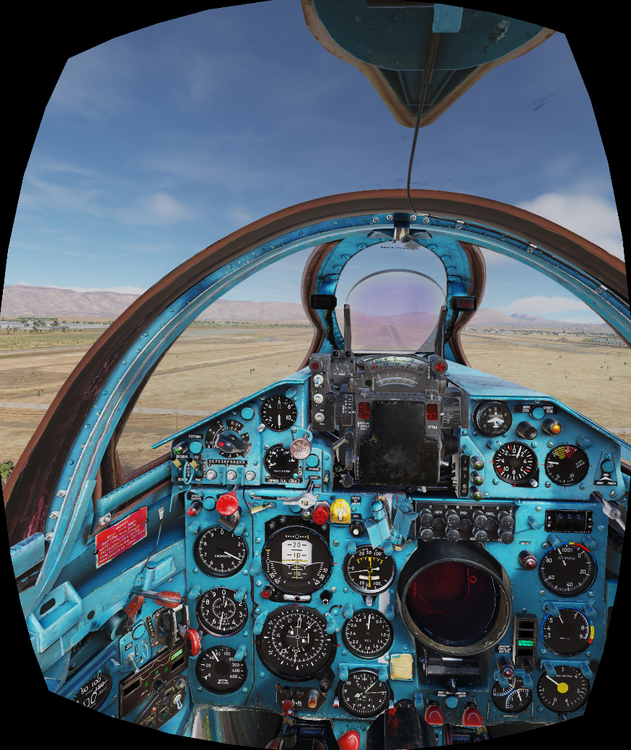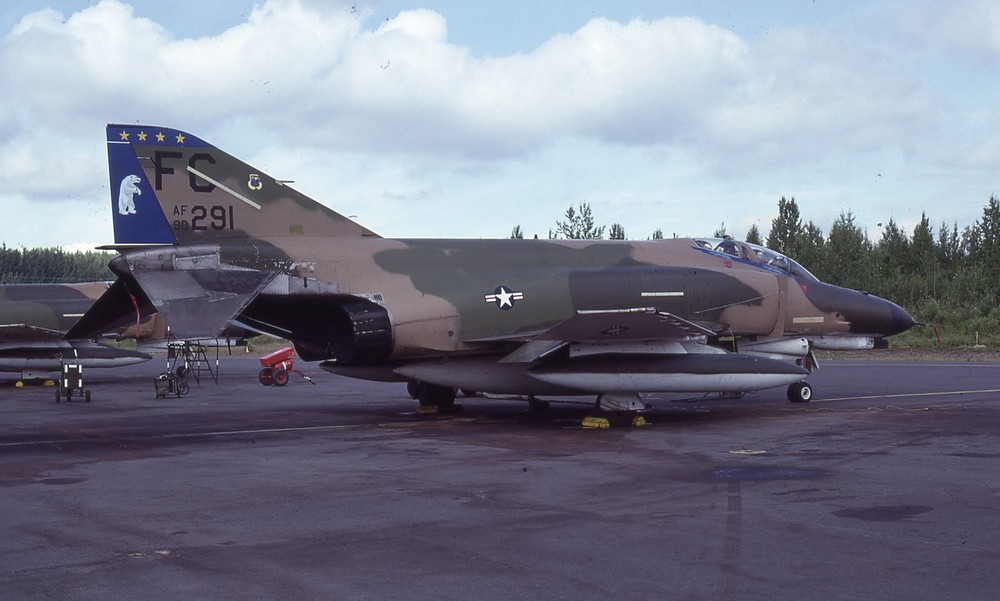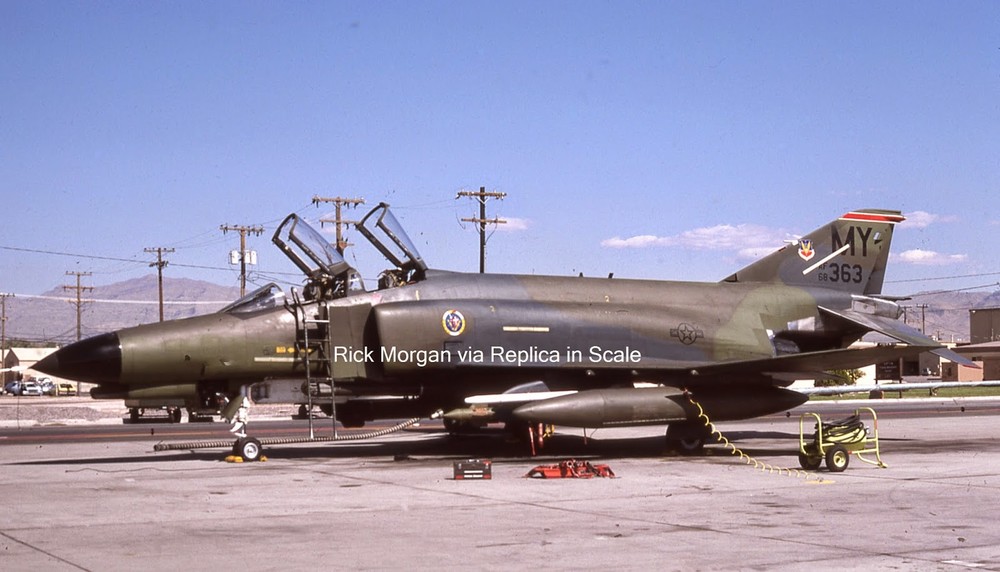

MBot
Members-
Posts
3938 -
Joined
-
Last visited
-
Days Won
19
Content Type
Profiles
Forums
Events
Everything posted by MBot
-
For me, this has been an issue with the MiG-21 for years. The problem seems to me how the canopy is affected by some kind of environmental lighting, i.e. the brightness of the terrain around you. The reflections on the canopy change massively depending on the type of terrain below you. Look at the screenshot below. I had trouble to see the runway directly ahead of me though the gunsight. The same effect often also be seen on the canopy, depending on attitude and brightness of terrain.
-
Neither of these target aircraft has a jammer, that is why you get hits. Neither the MiG-21 or MiG-23 from the Constant Peg Gen III has a jammer, that is why you get hits. The F-4 doesn't have a jammer either (unless a pod was equipped, which in this mission they have not). The Su-24 has a jammer. Can you confirm that you get Sparrow hits on them? In my tests, AIM-7M do not track Su-24. Again, the Su-27 doesn't have a jammer unless unequipped with a pod. The MiG-27 has an internal jammer, thus your Sparrows don't track. The MiG-21 has no jammer. All these Sparrow issues are jammer related.
-
Genuine question: You would prefer to not have Saratoga at all versus having a Saratoga with some incorrect masts or antennas? Because HB current plan as far as we know is doing only USS Forrestal.
-
I really hope that HB doesn't think they have to model all the differences between each ship in the class or do USS Forrestal only. Sometimes perfect is the enemy of good enough. I do strongly suggest that they just switch the name and the number between all 4 members of the class. Not having Saratoga, Ranger or Independence because some different mast arrangement would be a big and senseless loss. There are probably only a hand full of people that would ever notice such details (I might be one of them) and this is a flight sim after all. Having all the significant names of the class is much more important.
-

can not reproduce SA-6 Gainful not engaging AI units
MBot replied to GumidekCZ's topic in Ground AI Bugs (Non-Combined Arms)
This sounds incorrect. Maximum target altitude for the 9M3M3 missile (introduced 1976) is 14 km according to East German sources: http://www.rwd-mb3.de/pages/3m9.htm Perhaps ED is simulating the original 9M3M missile with an engagement altitude of 7 km, but I do not recall that the SA-6 had such a low engagement altitude in DCS previously. -
Phavorite Phantoms: 57 Fighter Interceptor Squadron, Keflavik, Iceland. Defending the Iceland from Soviet bombers 1978-1985 11 Tactical Fighter Wing, Elmendorf AFB, Alaska, 1977-1981 347th Tactical Fighter Wing from Moody AFB, Georgia. Picture taken 1986 in Nellis. New European camo, but the aircraft should still be in Vietnam-era configuration. Note Pave Spike and GBU-12.
-
Regarding the Vietnam vs 80s Phantom discussion, I would go with a late but pre-ARN-101 USAF F-4E (so the variant preceding the ARN-101 variant that Belsimtek had originally planned). This variant had an extensive service history, operating from the late stages of the Vietnam war, fought heavily with the IDF/AF in the 1973 Jom Kippur war (some aircraft actually still in USAF camo as they were emergency transferred directly from USAF units) and remained in front-line service well into the 1980s (86th TFW in Ramstein AB, Germany flew them until 1986). With this you get both worlds, Vietnam-era top-tier fighter and 1980s fighter-bomber. Compared to the ARN-101 you would not get CCIP bombing, having to rely on depressible pipper manual bombing, which I think would be more fitting to the classic Phantom vibe. You would not get Pave Tack FLIR, instead having early LGB deliveries using the Pave Spike TV pod. This actually sounds more interesting as this pod was much more hands-on for the WSO (I think it was just gyro stabilzed but not ground stabilized, so the WSO would have to track the target by hand). You would miss GBU-15, which admittedly would be a shame. You would still get early AGM-65A/B TV Mavericks and Shrike ARM though. Still a very potent fighter-bomber. Beautiful F-4E at Ramstein AB, Germany in 1984, armed with AIM-9J/P and AIM-7E, ready to go into battle with the Warsaw Pact.
-
6 A-7E from USS America supported the Tripoli area (8 Shrike and 16 HARM fired). I also refer to "Osprey Combat Aircraft 102: F-111 & EF-111 Units in Combat", where F-111 pilots mention concerns that Tomcats patrolling off-shore might mistake them for enemy aircraft when coming off target. No, the F/A-18 is not capable of terrain following flight in instrument meteorological conditions. Sorry, but you are very wrong about this. While the A-6 did perform all-weather CAS for the USMC, this was not its mission in the Navy. You must understand that, Submarine Launched Ballistic Missiles aside and prior to Tomahawk cruise missiles, the Intruder was the US Navy's primary nuclear and conventional strike system. As such, the Intruder must have been able to penetrate even the most heavily defended Soviet targets during its time. And while luckily it never had been necessary to prove this, it is generally accepted that it could. The support that point, the Soviets were opposed to the USMC deploying A-6E to Norway during NATO exercises, because of its nuclear strike capability against Soviet basis on the Kola peninsula. To not anger their neighbors, the Norwegian government allowed USMC deployments of A-4, F-4, Harrier etc. to Norwegian bases but never A-6E The A-6 was expected to (and did) perform the same deep strike missions for the USN as the F-111 did for the USAF. I guess just like Heatblur had to clear up some misconceptions about the Phoenix being just a bomber-killer, it will also have to teach a lot of people that the Intruder was not just a bomb truck.
-
The Navy provided fighter and SEAD support for the F-111 in the Tripoli area as well. The F-111 required a fleet of tankers, the A-6 a fleet of ships. Both dealt with reaching the target according to the doctrine of their respective service.
-
It did. Just look at Eldorado Canyon in 1986. Both types operated side-by-side, carrying out a similar mission. The F-111 struck in the west in the Tripoli area, A-6 struck in the east in the Benghazi area. Both areas were heavily defended (A-6 got shot at and dodged SA-3). By the way, one F-111 was shot down by a Shilka while the A-6 didn't suffer any losses.
-
Payload: In practical terms nearly identical. Range: Both aircraft are known to have very long range. The F-111 had a some more, the A-6 would generally start closer to its target due to being carrier base. In terms of DCS, both aircraft have plenty enough (combat radius beyond map size, so no practical difference). Speed: Attack speed for both will be high subsonic. Bombing attacks are generally not carried out at supersonic speed because of maneuverability and weapon separation concerns. The F-111 will perhaps have 100 kts extra during the attack. The F-111 will of course have the superior dash speed if required. It should be noted though that in the era most relevant for both types (Cold War), low level flight at night made aircraft practically immune from interception from most Soviet aircraft such as MiG-21, MiG-23, MiG-25 or Su-15. Some people might argue the MiG-23, but I stand by it (and with it MiG-29, which has basically the same radar performance as late Floggers). Su-27 would start to become a problem, but they started to appear only at the end of the 80s. The biggest threat was the look-down/shoot-down capability of the MiG-31. The A-6 would have to deal with those in certain areas it was expected to operated (Kamchatka, Sakhalin, Kola). MiG-31 would also have been a big problem for the F-111, but it did not operate in Eastern Europe, so the F-111 out of England would not have met them. In general, low level night flight was considered to be sufficient protection from the most common Soviet fighters regardless of own speed. The task and mission profile of both types was very similar. Let me quote Aviation author Rick Morgan: "The General Dynamics F-111 was the closest thing the Air Force had to the Intruder, at least in terms of mission, if not performance." I am a big fan of both types.
-
The irony in this is that the F-111 and the A-6 have *exactly* the same mission: Low level attack in instrument flight conditions. Granted, the F-111 is about 50% faster in a dash (Mach 0.8ish vs. Mach 1.2ish), but for the vast majority of the low level penetration both types will fly at subsonic speed (because fuel). How much of the dash speed difference is really noticeable in instrument flight is another question. From RL tactical point of view and a DCS gameplay point of view, both aircraft are virtually identical.
-
Regarding a flyable KA-6D. The A-6E could and very frequently did equip a buddy refueling pod, and with such had identical fuel offloading capabilities as the KA-6D. In fact, even the KA-6D frequently used the buddy pod itself. So if you want to refuel other aircraft, the vanilla A-6E could easily do it as well. Of course either with the KA-6D or A-6E, human tankers would require major coding by ED first.
-
I have the impression that A-6E is a given, so the question is whether TRAM or SWIP. With regards to the eventual flyable variant at least, for the AI version it won't really matter externally. I am strongly in favor of the TRAM, as with its service entry in 1979 it represented the Navy's primary attack platform for this critical Cold War era. SWIP only entered service in 1990 or so and in the 1991 Desert Storm, only 2 of 9 participating A-6E squadrons flew SWIP instead of TRAM. So in my opinion, TRAM is definitely the most historically significant variant. I understand that many will desire the latest and greatest weapons added with SWIP, most importantly HARM. Personally I think that HARM turned out to be a rather boring weapon (as experienced in other DCS modules). Shrike was a much more interesting and exciting to use, as it required the shooter to fly into the threat envelope of the SAM. The same with SLAM. I would caution to not repeat the mistake done with selecting the AJS-37 over the AJ-37, where in my opinion the "best" variant took away some of the charm of the original design. HB went to great length to model the peculiarities of the Viggen's original navigation system, then added the TERNAV system of the S modifications which basically made making any nav fixes unnecessary. Wasn't it frustrating for HB to see, that after spending so much effort to simulate the nav fixes, almost no one actually uses them (with TERNAV, the Viggen basically navigates as effortless as with GPS)? My mistake! Good to know we have at least a little more options then. Perhaps it will satiate the folks wanting a Prowler, seeing as how that’s about as much as it would offer to DCS until ECM and jamming is more accurately modelled. I would caution that VX-5 was a test an evaluation squadron. HARM hit the fleet with the A-6E SWIP in 1990.
-
Actually, STARM disappeared ahead of the platforms dedicated to launch it because of cracks in the missile propellant, around 1986.
-
There is a nice article on the AWG-21 jets: http://rickmorganbooks.com/a-6e-anawg-21.html
-
The A-6's primary mission was low level penetration and strike in instrument flight conditions (night and/or adverse weather). This was a quite unique and very important capability during its time, which only few other types were also capable of. Initially the Air Force F-111, then also Tornado and Su-24. By the end of the Cold War it became a little more widespread but still highly specialized capability. The Intruder operated during the day, but crews generally thought it was a wast of their unique capabilities. In Vietnam, the A-6 made low level night strikes but also participated in medium altitude daylight alpha strikes, where the type would attack in large formations together with other aircraft in the carrier air wing. While the A-6 could carry a lot of ordinance, during these alpha strikes it would basically do the same things that other, much cheaper aircraft did. That is why the crews wanted to use the Intruder in low-level night strikes only, where it offered its additional value, justifying its high complexity and cost. A signature Intruder mission were the strikes on Libya during Eldorado Canyon in 1986, where VA-34 and VA-55 A-6E struck barracks and an airfield covered by SA-2 and SA-3. The Intruders went in at night in a bomber stream (a series of aircraft flying individually in a line), going over the beach at 300 ft and popped up to 500 ft to deliver Snakeyes, retarded Mk-83 and cluster bombs. During Desert Storm, A-6E conducted 72.5% of their sorties at night and 27.5% during the day.
-
Yes sure, because the helicopter AI in DCS is awful. It only works as long as it can shoot missiles from stand-off at high altitude (for a helo). So not fitting the combat doctrines of both the Hind or the Apache against a mechanized enemy at all.
-
Yes, but it is the lowest setting that is in use predominately and that we are used to with regards to AI accuracy. Also for some weird reason the skill settings are called: Average Good High Excellent In what world is average the lowest end of the spectrum? It would have made sense to scale these among the complete spectrum and give them a descriptive name that the user can actually connect with reasonable expectations. Such as: Untrained: Struggles with even operating the weapon system. For example insurgents that have captured a tank, or someone that closed his eyes when shooting a rifle. Trained: Got basic training to use the weapon system but has no further combat experience. Veteran: Either with combat experience or extensive combat-like training. For example Iraqi republican guard or most NATO troops. Elite: Special forces like abilities. You realize though that I suggested you make the test with the lowest skill level available and see for yourself?
-
May I suggest you make an experiment in the ME? Place a platoon of M2 Bradley (4 units) with the lowest skill level and let it be attacked by a AI Mi-24V limited to rockets (so no ATGM). Note how often the Hind will survive a single attack (spoiler: rarely). You can repeat the test with various APC and IFV, such as M113, LAV-25, BMP-2, Marder, Warrior, BTR-80 etc. I hope some people at ED do these sort of things, because it will determine weather the DCS Hind will be a usable singleplayer product or not. I may be able to overcome the ground AI, but my AI wingmen and any other allied flight will not. I am worried.
-
Another interesting question is whether ED plans to improve helicopter AI to include NOE flight and pop-up attacks (I doubt it) or whether in SP I will be the sole Hind on a high intensity battlefield (I expect so).
-
Well that is at least debatable. I owned the original Black Shark (pre-DCS) and didn't buy it again for DCS simply because it was unsatisfactorily to me. The wining tactic has always been parking at stand-off and shoot things at distance like fish in a barrel. As a Cold War enthusiast I have zero interest in this. My big fear is that this will also be the way the Apache will be used in DCS. All those detailed system simulations mean nothing to me if there is no interesting tactical application and hands-on flying.
-
How DCS as an environment will accommodate the Hind is also one of my biggest concerns. 1. Ground AI spotting and how the concept of surprise, ambush or distraction isn't existent, critical elements of attack helicopter operations. 2. Ground AI target acquisition speed and accuracy when engaging aircraft, especially with main guns, auto-cannons and co-axial guns. I fully support that stationary helicopters are eventually engaged with all available weapons (after a certain time, because acquiring aircraft from within vehicles is difficult), but there should be more strict limitations when engaging moving aircraft without dedicated anti-air sights. Aiming at moving aircraft with sufficient lead would often put the target outside the field of view of a fixed tank sight such as installed in the BMP-2 for example. 3. No suppression mechanic for ground AI. 4. Lack of type variety and behaviour fidelity of AI infantry, one of the primary mission targets for the Hind (the famous rocket attacks are aimed mostly at infantry).
-
That sounds a little disappointing, as I think the SA-7 is a huge hole in DCS' lineup of air defense systems. For example, between 1970 and 1983, the Soviet Union exported 15'000 (!) SA-7/Strela-2 missiles to Syria. Just let that number sink in for a moment... ED's perception that no one would want to use not-the-latest weapons for historical scenarios offers some insight into their thinking.
-
I was wondering about this as well. Is this a new functionality where a deception jammer can break a lock? Or was the video simply deliberately set up with threat beyond the good old noise-jamming burn-through range? In this case we would simply see a loop of lock->noise jammer->lock lost->no noise jammer->lock->noise jammer etc., which would mean that jammers remain pointless as burn-through range is almost always bigger than engagement range (perhaps there are some minor exceptions).




.thumb.jpg.0aba39c0e649887f5983d02192b20de2.jpg)


.thumb.jpg.80911b1a9e1e0421cee0962e3128d078.jpg)